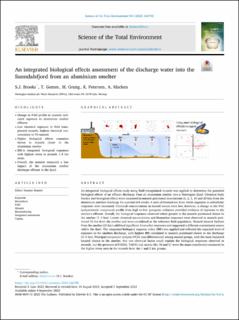| dc.contributor.author | Brooks, Steven | |
| dc.contributor.author | Gomes, Tania | |
| dc.contributor.author | Grung, Merete | |
| dc.contributor.author | Petersen, Karina | |
| dc.contributor.author | Macken, Ailbhe | |
| dc.date.accessioned | 2023-11-14T13:37:49Z | |
| dc.date.available | 2023-11-14T13:37:49Z | |
| dc.date.created | 2023-10-05T14:07:37Z | |
| dc.date.issued | 2023 | |
| dc.identifier.citation | Science of the Total Environment. 2023, 904, 166798. | en_US |
| dc.identifier.issn | 0048-9697 | |
| dc.identifier.uri | https://hdl.handle.net/11250/3102511 | |
| dc.description.abstract | An integrated biological effects study using field transplanted mussels was applied to determine the potential biological effects of an effluent discharge from an aluminium smelter into a Norwegian fjord. Chemical body burden and biological effects were measured in mussels positioned downstream (1, 2, 5, 10 and 20 km) from the aluminium smelters discharge for a period of 6 weeks. A suite of biomarkers, from whole organism to subcellular responses were measured. Chemical concentrations in mussel tissues were low; however, a change in the PAC (polyaromatic compound) profile from high to low pyrogenic influence provided evidence of exposure to the smelter's effluent. Overall, the biological responses observed where greater in the mussels positioned closest to the smelter (1–5 km). Lowest chemical accumulation and biomarker responses were observed in mussels positioned 10 km from the smelter and were considered as the reference field population. Mussels located furthest from the smelter (20 km) exhibited significant biomarker responses and suggested a different contaminant source within the fjord. The integrated biological response index (IBR) was applied and reflected the expected level of exposure to the smelters discharge, with highest IBR calculated in mussels positioned closest to the discharge (1–5 km). Principal component analysis (PCA) also differentiated among mussel groups, with the most impacted located closest to the smelter. Not one chemical factor could explain the biological responses observed in mussels, but the presence of PAH16, PAH41 and metals Mn, Ni and Cr were the main contributors measured to the higher stress seen in the mussels from the 1 and 5 km groups. | en_US |
| dc.language.iso | eng | en_US |
| dc.publisher | Elsevier | en_US |
| dc.rights | Navngivelse 4.0 Internasjonal | * |
| dc.rights.uri | http://creativecommons.org/licenses/by/4.0/deed.no | * |
| dc.title | An integrated biological effects assessment of the discharge water into the Sunndalsfjord from an aluminium smelter | en_US |
| dc.type | Peer reviewed | en_US |
| dc.type | Journal article | en_US |
| dc.description.version | publishedVersion | en_US |
| dc.rights.holder | © 2023 The Authors | en_US |
| dc.source.pagenumber | 14 | en_US |
| dc.source.volume | 904 | en_US |
| dc.source.journal | Science of the Total Environment | en_US |
| dc.identifier.doi | 10.1016/j.scitotenv.2023.166798 | |
| dc.identifier.cristin | 2182096 | |
| dc.source.articlenumber | 166798 | en_US |
| cristin.ispublished | true | |
| cristin.fulltext | original | |
| cristin.qualitycode | 2 | |

